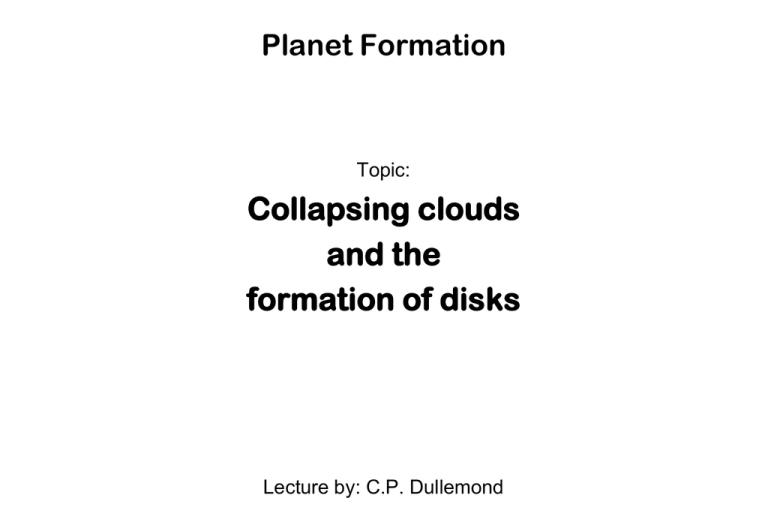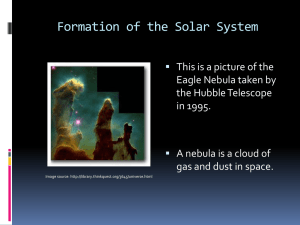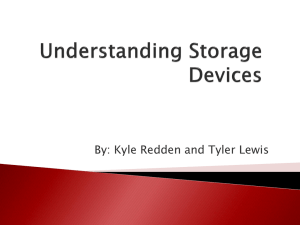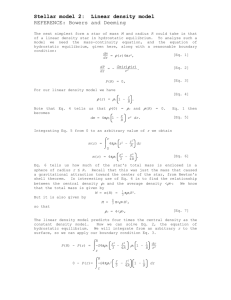Disk formation
advertisement

Planet Formation Topic: Collapsing clouds and the formation of disks Lecture by: C.P. Dullemond Formation of a star from a spherical molecular cloud core Hydrostatic pre-stellar Cloud Core Equation of hydrostatic equilibrium: 1 dP(r) GM (r) =r (r) dr r2 r Enclosed mass M(r): M(r) º ò r 0 Equation of state: P = rc 2 s 4p r' r(r') dr' 2 Isothermal sound speed: kT c º = const. m mH 2 s We assume that cloud is isothermal at e.g. T = 30 K Hydrostatic pre-stellar Cloud Core Ansatz: Powerlaw density distribution: q ærö r (r) = r0 ç ÷ è r0 ø Put it into pressure gradient: q 2 æ ö dP(r) d r cs r0 q q-1 2 d r (r) 2 = cs = cs r0 ç ÷ = r q dr dr dr è r0 ø r0 Divide by density: 1 dP(r) c q = r (r) dr r 2 s Hydrostatic pre-stellar Cloud Core Ansatz: Powerlaw density distribution: q ærö r (r) = r0 ç ÷ è r0 ø Put it into the enclosed mass integral: M(r) º ò r 0 4p r' r(r') dr' 2 4pr0 r 2+q = q ò (r ') dr ' 0 r0 4pr0 é 3+q ùr = (r ') û që 0 (3+ q)r0 4pr0 3+q = r q (3+ q)r0 (for q>-3) Hydrostatic pre-stellar Cloud Core 1 dP(r) c q = r (r) dr r 2 s GM (r) 4p Gr0 1+q =r 2 q r (3+ q)r0 Put it into the hydrostatic equil eq.: cq 4p Gr0 1+q =r q r (3+ q)r0 2 s Only a solution for q=-2 2c 4p G r 0 2 =r0 r r 2 s c r0 = 2p Gr02 2 s Hydrostatic pre-stellar Cloud Core c r0 = 2 2p Gr0 2 s q and ærö r (r) = r0 ç ÷ è r0 ø gives: cs2 r (r) = 2 2p Gr Singular isothermal sphere hydrostatic solution Inside-out Collapse The idea by Frank Shu (the „Shu model“) is that a singular isothermal sphere may start collapsing once a small disturbance in the center makes the center lose its pressure. Then the next mass shell loses its support and starts to fall. Then the next mass shell loses its support and starts to fall. Etc etc. Inside-out collapse. Wave proceeds outward with the isothermal sound speed. Inside-out Collapse Once a shell at radius r starts to fall, it takes about a free-fall time scale before it reaches the center. This is roughly the same time it took for the collapse wave to travel from the center to the radius. Let us, however, assume it falls instantly (to make it easier, because the real solution is quite tricky). The mass of a shell at radius r and width dr is: 2 2 2 4 p c r dr 2c 2 s s dM (r) = 4p r (r)r dr = = dr 2 2p Gr G Inside-out Collapse Sind the collapse wave propagates at dr = cs dt Meaning we get a dM(r) of 2cs2 2cs3 dM (r) = dr = dt G G If we indeed assume that this shell falls instantly onto the center (where the star is formed) then the mass of the star increases as dM 2cs3 = dt G If we account for the free-fall time, we obtain roughly: dM c = dt G 3 s The „accretion rate“ is constant! Formation of a disk due to angular momentum conservation Ref: Book by Stahler & Palla Formation of a disk Solid-body rotation of cloud: z v 0 = w r0 sinq0 0 v0 j = r0 v0 << GMr0 r0 x y Assume fixed M Infalling gas-parcel falls almost radially inward, but close to the star, its angular momentum starts to affect the motion. At that radius r<<r0 the kinetic energy v2/2 vastly exceeds the initial kinetic energy. So one can say that the parcel started almost without energy. Formation of a disk Simple estimate using angular momentum: j = w r0 sinq 0 z 2 jz = w r0 sin q 0 2 0 v0 r0 x Kepler orbit at r<<r0 has: jK (r) = GMr y Setting 2 jK (r) = jz yields jz2 w 2 r04 sin 4 q 0 r= = GM GM Formation of a disk Bit better calculation Focal point of ellipse/parabola: a + r = const = re = 2rm v 2 GM º @0 2 r 2GM v = rm No energy condition: etot Ang. Mom. Conserv: j = v r = 2GM rm = GM re 2 2 m 2 2 m m Radius at which parcel hits the equatorial plane: j2 w 2 r04 sin 2 q 0 re = = GM GM re Equator a r rm vm Formation of a disk Since also gas packages come from the other side of the equatorial plane, a disk is formed. With which angular velocity will the gas enter the disk? jz = w r02 sin 2 q 0 Kepler angular momentum at r=re: jKe = GMre = w r02 sinq 0 Their ratio is: jz = sin q 0 jKe The infalling gas rotated sub-kepler. It must therefore slide somewhat inward before it really enters the disk. Formation of a disk For larger 0: larger re For given shell (i.e. given r0), all the matter falls within the centrifugal radius rc onto the midplane. rc = re (q0 = p /2) = w 2 r04 GM If rc < r*, then mass is loaded directly onto the star If rc > r*, then a disk is formed In Shu model, r0 ~ t, and M ~ t, and therefore: rc µ t 3 Formation of a disk • This model has a major problem: The disk is assumed to be infinitely thin. As we shall see later, this is not true at all. • Gas can therefore hit the outer part of the disk well before it hits the equatorial plane. Disk formation: Simulations Yorke, Bodenheimer & Laughlin (1993)








